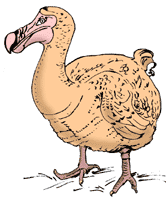
Dimdima
Online Children's Magazine from India

Dimdima
Online Children's Magazine from India
By Rani Iyer

The Dodo is a lesson in extinction. First sighted around 1500 on Mauritius Island in the Indian Ocean, the last mention of Dodo was made in 1681. Today we only have skeletons! How did Dodo become extinct? Human beings played a major role in this.
In 1505 Portuguese captain Pedro Mascarenhas discovered Mauritius and the Reunion Islands. Here, they found large, flightless birds that weighed about 15 to 20 kg. It lived and nested on the ground, eating fruits that fell from the trees. There were no mammals on this island, although a large number of bird species lived in the dense forests. The sailors found that the birds were easy prey and welcome source of fresh meat. There are reports of sailors killing 50 birds, so that they could 'salt the meat and take them on their journeys'.
Dutch word "dodoor" which means sluggard and Portuguese word "doudo" meaning foolish or simple, are thought to be the origin of the word Dodo.
Soon Mauritius became a regular haunt of the spice traders. However it was the conversion of Maruritius into a penal colony by the Dutch in 1644 that tipped the balance against Dodo. The settlers cleared the forests, and brought with them dogs, cats and guns that put the last Dodo in a cooking pot in 1681. Today no museum in the world has a complete specimen of Dodo.
Dodo, Raphus cucullatus, is related to doves, and has evolved from ancestors who could fly. Due to isolation and absence of predators, they lost their ability to fly. Scientists today use the skeleton, and descriptions of the bird in sailor's notes to reconstruct the life and habit of Dodo. The diet is thought to include fish, and fruits. However, Dodo also ate some stones to aid digestion. Dodo made their nest of grass deep in forest and laid one egg and raised it. The bird could not fly or walk fast. Dodo wobbled and the belly would drag on the ground amusing the sailors. The only defense of the bird was a sharp beak, which it used to deliver fearsome bites.
Until recently, the story of Dodo did not receive much attention. It was when ecologists discovered that one tree species were becoming very rare, because the oldest surviving members were 300 years old. Only those seeds that passed through the digestive system of Dodo could grow into plants! Therefore now the loss of Dodo is being critically examined.
Last updated on :2/14/2004
EXPLORE MORE...
COMMENT ON THIS ARTICLE
Wants to share something related to this article? Please use the form below.
Dimdima is the Sanskrit word for ‘drumbeat’. In olden days, victory in battle was heralded by the beat of drums or any important news to be conveyed to the people used to be accompanied with drumbeats.
Bharatiya Vidya Bhavan
K. M Munshi Marg,
Chowpatty, Mumbai - 400 007
email : editor@dimdima.com
Bharatiya Vidya Bhavan
505, Sane Guruji Marg,
Tardeo, Mumbai - 400 034
email : promo@dimdima.com
Dimdima.com, the Children's Website of Bharatiya Vidya Bhavan launched in 2000 and came out with a Printed version of Dimdima Magazine in 2004. At present the Printed Version have more than 35,000 subscribers from India and Abroad.